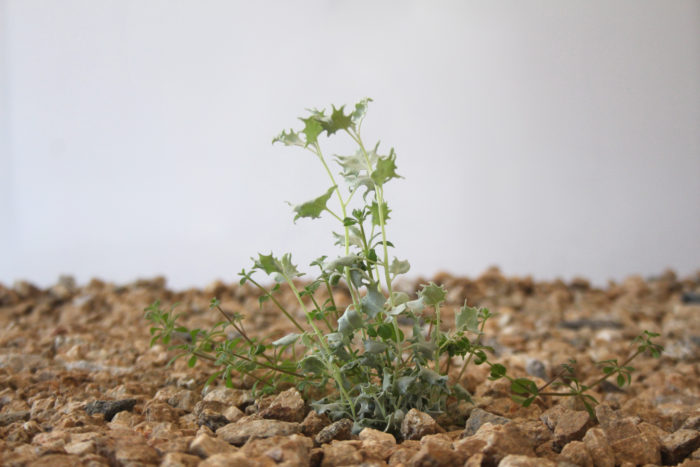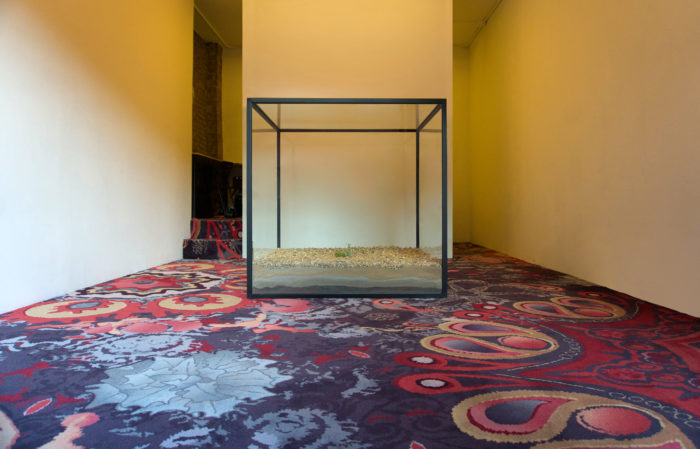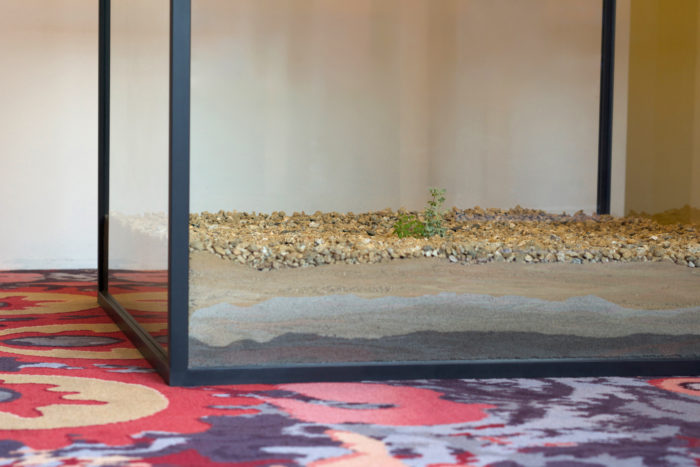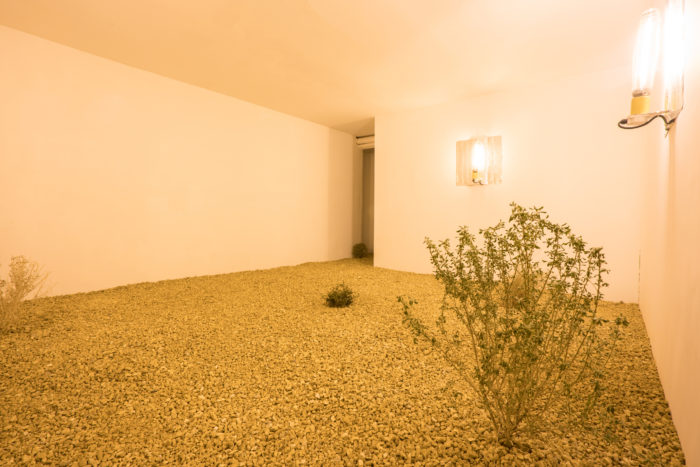
Martin Roth was born in Austria but has made his home in New York City for more than a decade. He received his MFA from Hunter College in 2011, and now is concentrating on his specialty–highly lyrical, highly conceptual artworks that often involve nature. Sometimes the expression of his projects is gentle: a year ago, in May 2017, he shipped 8000 pounds of earth to the Austrian Cultural Forum, located in midtown New York. Attempting to offset the stress caused by Trump and his inner circles’ tweets and re-tweets. Roth grew six rows of lavender in the basement of the Forum’s bunker-like basement and connected the intensity of the grow lights to the frequency of Trump and his associates’ tweets. Lavender is known for its calmative and sleep-inducing qualities–psychiatric aids that the artist hoped to provide to those collectively suffering from the excess of Trump’s presidency. There was a lyric beauty and also a bit of humor to this installation, but for the present show, entitled In November 2017 I collected a plant from the garden of a mass shooter, the theme is irredeemably dark. The two small spaces Roth uses in the gallery, located on the Lower East Side, consist of gravel and plants shipped from a plant nursery close to the home of Stephen Paddock, the Las Vegas Strip shooter who last October killed 58 people and injured close to 600 with an arsenal of guns he had amassed in the hotel he was staying.

Roth visited Paddock’s home an hour away from Las Vegas, and studied the very barren gravel garden on the property. Finding only randomly planted scrubs and bushes, Roth did come across, after close inspection, a very small wild plant: desert holly, the most drought-tolerant saltbush found in the American Southwest. Roth, having read that the plants we need for healing are often found close to our home, incorporated the desert holly shrub into the upstairs installation in the gallery. Visitors entering the gallery’s small space were immediately immersed in the artist’s bizarre commemorative of the worst mass shooting ever to have taken place in American history. The colorful carpet, a mixture of irregular patterns against a red background, is a reproduction of the hallway carpet that led to Paddock’s room at the Mandalay Bay Hotel. Roth incorporated drawings of the desert holly into the duplicated carpet. In the middle of the room is a large vitrine, in which gravel local to Paddock’s environs covered the floor, with the desert holly plant occupying the center.

The piece is powerful enough to be experienced in and of itself as a formal exercise. But that, of course, would severely limit the moral meaning of the project, something Roth intends, and which we clearly recognize in its presentation (if we know the story beforehand!). Many of Roth’s projects are only fully understood when viewers know the circumstances before their making. Sometimes, or even often, the way the situation is referred to is oblique and abstract, and these qualities result in an intellectual gap between the art world, which usually comprehends notions peripheral to but also highly influential on the visual things making up the work of art, and the general public, which may not easily comprehend the artwork’s unexplained aura. This is the problem with this kind of art, which, even if Roth practices it very well–and he does–implies rather than openly states the context of what we see. The visual complexity that sustains this very good show presupposes high analytic and creative intelligence for an insightful response.

In the lower level, on the wall, Roth has installed three very bright lights, which disorient his audience. Beneath the intense, disconcertingly brilliant glare of the lamps, six small disheveled shrubs rise up from the gravel. In three locations, Roth has installed small motors beneath the floor; they powerfully shake the viewer should he or she happen to be standing in their proximity. The motors are programmed to do this every four minutes and ten seconds–the length of time between mass shootings that occurred in 2017 if that year were compressed into a 24-hour period. As a distanced, abstract re-envisioning of Paddock’s murders, the two spaces are brutally current interactions between the imagination and the actual event. But there is no direct reference to the tragedy itself; Roth’s visuals are subtly distant from the murders that took place. For those who feel impelled to do so, at the gallery entrance there are forms to sign that ask for gun registration with stricter gun laws–one can be an immediate activist in the face of the story behind Roth’s two environments.

Artist Roth has given us a brilliant interpretation of a horrible crime. It occurs in the form of subtle natural references that tie the murders to the domestic garden of Paddock. The installations become more and more powerfully resonant when we understand that they are dealing with the gun violence overtaking America on a regular basis. Roth makes us ask about the philosophical underpinnings of this kind of art. In their totality, the two works engage us visually and morally at once; however, their moral aspect occurs outside the pieces we see. Indeed, Roth’s ethical vision is made distant by virtue of silent report. The silence makes the ethical insight extremely difficult to understand in light of the real (but invisible) evidence of overwhelming violence–even if the visuals occur in response to something that is not there to grasp. This show admirably succeeds in communicating the horrific effects of unchecked gun possession. Mass shootings in America occurred 345 times in 2017. Roth makes it clear, despite the metaphorical nature of his presentation, that this can no longer be tolerated.
Martin Roth – In November 2017 I collected a plant from the garden of a mass shooter
March 31 – May 13, 2018
yours mine & ours gallery
54 eldridge street
New York, NY. 10002
Jonathan Goodman
